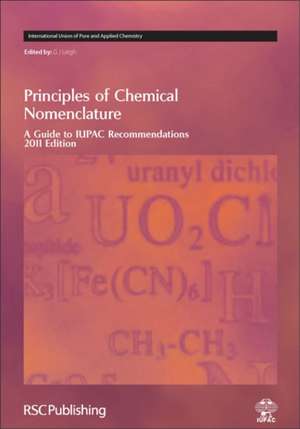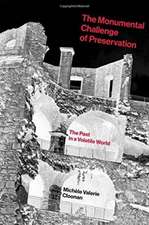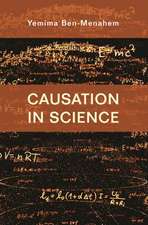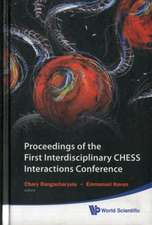Principles of Chemical Nomenclature: International Union of Pure and Applied Chemistry (Hardcover)
en Limba Engleză Hardback – 31 aug 2011
The ultimate aim of IUPAC nomenclature is to provide unequivocal and comprehensible names for all kinds of chemical structures. This requires a rational basis from which comprehensible names can be developed. Written by leading world authorities this second edition of Principles of Chemical Nomenclature outlines IUPAC recommendations for application in the principle branches of chemistry: organic, inorganic, organometallic, and polymer. It also includes some basic biochemical nomenclature. The book clearly explains the fundamental principles of nomenclature methods and enables the reader to apply them accurately and with confidence. New developments are described and additional nomenclature systems used in specific industries are introduced. The book is replete with examples for guidance and there are extensive tables to direct the reader to information quickly. Aimed at chemistry teachers and students at all levels, it advises on the best presentation of formulae and chemical graphics. Although rather advanced for school pupils, their teachers will find it useful.
Preț: 250.32 lei
Nou
Puncte Express: 375
Preț estimativ în valută:
47.90€ • 50.01$ • 39.64£
47.90€ • 50.01$ • 39.64£
Carte disponibilă
Livrare economică 14-28 martie
Preluare comenzi: 021 569.72.76
Specificații
ISBN-13: 9781849730075
ISBN-10: 1849730075
Pagini: 257
Ilustrații: 138 black & white illustrations
Dimensiuni: 192 x 278 x 25 mm
Greutate: 0.73 kg
Ediția:Nouă
Editura: Royal Society Of Chemistry
Seria International Union of Pure and Applied Chemistry (Hardcover)
ISBN-10: 1849730075
Pagini: 257
Ilustrații: 138 black & white illustrations
Dimensiuni: 192 x 278 x 25 mm
Greutate: 0.73 kg
Ediția:Nouă
Editura: Royal Society Of Chemistry
Seria International Union of Pure and Applied Chemistry (Hardcover)
Cuprins
Foreword; Introduction; Definitions; Formulae; Types of Nomenclature; Binary Nomenclature; Substitutive Nomenclature; Additive Nomenclature; Organometallic Nomenclature; Polymer Nomenclature; Boron Hydrides; Biochemical Nomenclature; Other nomenclatures; Name Construction and Deconstruction; InChIs; Future developments; Graphical representation.
Recenzii
Perhaps the most significant addition to the recommendations is the chapter on the nomenclature of organometallic compounds. The Red Book can help chemists create names from structures, or decipher names to give structures.
Chemistry International, September-October 2007 (review of previous IUPAC edition)
Chemistry International, September-October 2007 (review of previous IUPAC edition)
Notă biografică
G.J. Leigh is Emeritus Professor at the University of Sussex and has been active in IUPAC nomenclature since 1973.
Textul de pe ultima copertă
Precise and accurate nomenclature is a vital aspect of chemistry. IUPAC nomenclature provides unequivocal names for all kinds of chemical structures. This requires a rational basis from which comprehensible names can be developed. Written by leading world authorities, Principles of Chemical Nomenclature enables teachers and students to obtain a sound training in IUPAC nomenclature. It outlines IUPAC recommendations for application in the principle branches of chemistry: organic, inorganic, organometallic, and polymer. It also includes some basic biochemical nomenclature. The book clearly explains the fundamental principles of nomenclature methods and enables the reader to apply them accurately and with confidence. The book is replete with examples for guidance and there are extensive tables to direct the reader to information quickly. The new edition takes a slightly different approach to the original. Discussions of other nomenclatures used in specific industries have been added. These include the IUPAC International Chemical Identifier (InChI) and the Preferred IUPAC Names (PINs). Nomenclature, just like chemistry, is a subject that develops continually. New classes of compound require new adaptations of nomenclature and IUPAC tries to provide these. The changes in IUPAC recommendations since publication of the first edition have been incorporated. This expansion of coverage required additional expertise so the writing of the new edition has been divided amongst a group of specialist writers. Aimed at chemistry teachers and students at all levels, this book advises on the best presentation of formulae and chemical graphics. Although rather advanced for school pupils, their teachers will find it useful.
Descriere
Aimed at pre-university and undergraduate students, this volume surveys the current IUPAC nomenclature recommendations in organic, inorganic and macromolecular chemistry.

















